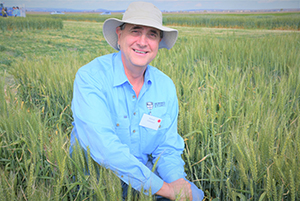More heat tolerant wheat varieties on the breeding cards
Date: 13 Nov 2020

The ability of heat stress to severely undermine the yield potential of wheat crops is a well-recognised production risk among Australian grain growers who routinely consider temperature outlooks within their agronomic management planning.
However, with predictions that heat waves and temperature volatility will become more frequent occurrences in Australia in coming decades, researchers are working tirelessly to improve the heat tolerance of varieties through targeted genomic selection.
A rigorous comparison of the yield performance of thousands of wheat lines has been undertaken at the University of Sydney’s Plant Breeding Institute (PBI) at Narrabri in New South Wales under different times of sowing, heat shock conditions and within temperature-controlled greenhouses.
Similar trials have been conducted in major growing regions in Western Australia and Victoria, delivering remarkably consistent results.
The research is a key investment for the Grains Research and Development Corporation (GRDC) and has been conducted by the University of Sydney-PBI with assistance from Agriculture Victoria, Flinders University, Merredin Managed Environment Facility, Australian Grain Technologies and Intergrain.
Professor Richard Trethowan, from the University of Sydney, said the evaluation of new materials developed from diverse genetic backgrounds using field-based phenotyping and genomic selection suggested that current levels of heat tolerance could be substantially improved.
Professor Trethowan explained the objectives and outcomes of the research in a recently-released GRDC video explaining new research investigating better wheat yields from improved heat tolerance.
“The ultimate aim of the program is to identify lines that perform very well when sown optimally and maintain yield when temperatures are high,” Professor Trethowan said.
“While years of breeding selection has resulted in many current Australian wheat varieties possessing heat tolerance, the research has identified genetic material that offers superior heat tolerance potential, which can be used to mitigate the effects of a warming climate.”
Periods of extreme high temperature, particularly short periods of heat shock, are a major threat to wheat yield and grain quality throughout much of the Australian wheat belt.
Observations at PBI since 2012 suggest that every one degree Celsius rise in average maximum seasonal temperature reduces wheat yields by 250-400 kilograms per hectare.
Heat shock occurs when there are at least three to five days of temperatures above 35 degrees Celsius, and when this coincides with meiosis/flowering, grain number and therefore yield is reduced.
Temperatures above 35 degrees Celsius during grain fill will also impact yield by reducing grain weight and increasing screenings.
To progress genetic improvement for heat tolerance, Professor Trethowan said it was imperative for researchers to have a relevant, effective and repeatable phenotyping strategy.
“Over time, researchers at PBI have developed a three-tiered scheme for phenotyping for heat tolerance,” he said.
“Stage one involves time of sowing trials under irrigation, stage two evaluates the lines which demonstrated a level of heat tolerance for response to heat shock using field-based heat chambers and stage three focuses on the delivery of controlled heat stress in glasshouses to assess the impact on pollen.
“The pollen impact is extremely important – results from one of the heat susceptible varieties showed that heat shock reduced pollen viability by two thirds.
“If we can introduce a gene for enhanced pollen viability under heat and another gene which maintains grain weight under high temperatures, then it allows the sowing window to become a little wider despite tougher growing conditions.”
The success of the phenotyping strategy being implemented at PBI has helped establish a successful genomic selection strategy for heat tolerance.
“We’ve reduced the cycle time of cross to cross from six to seven years to two to three years,” Professor Trethowan said.
“Because we now have an extensive genetic profile of a broad range of material, we can combine the genetics, the field responses, the heat chamber responses and the glasshouse responses to calculate genomic estimated breeding values (GEBVs) and quantitative trait loci (QTL) linked to heat tolerance traits.
“There’s enormous value in that germplasm for plant breeders who are interested in heat tolerance.”
There are two models used to calculate GEBVs – a baseline model which only predicts the overall GEBV of each genotype and a more sophisticated model which incorporates genotype-by-environment interaction.
“From there we take those lines with the highest breeding values and test them in Western Australia and Victoria to confirm that these responses are transferable across environments on the basis of that breeding value,” Professor Trethowan said.
“What we’ve seen is good correlation in predictability across the different regions as well as good prediction accuracy when the sophisticated model is used.
“Better predictions mean better germplasm and better varieties for grain growers.”
For more information, read Professor Trethowan’s 2020 GRDC Grains Research Update paper Maintaining wheat yield under high temperatures – how do current cultivars compare with what’s coming?.
ENDS
Contact Details
Contact
Toni Somes, GRDC
Toni.somes@grdc.com.au
0436 622 645
GRDC Project Code: US00081,
Was this page helpful?
YOUR FEEDBACK
